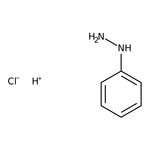Search Thermo Fisher Scientific
Phenylhydrazine, 97%, Thermo Scientific Chemicals



Phenylhydrazine, 97%, Thermo Scientific Chemicals
Chemical Identifiers
Specifications
Description
This Thermo Scientific Chemicals brand product was originally part of the Alfa Aesar product portfolio. Some documentation and label information may refer to the legacy brand. The original Alfa Aesar product / item code or SKU reference has not changed as a part of the brand transition to Thermo Scientific Chemicals.
Phenyl hydrazine is involved in Fischer indole synthesis to prepare indoles, which find application as intermediates in the pharmaceuticals particularly for the tryptamine drug. In analytical chemistry, it is used to differentiate and separate sugars by forming phenyhydrazones. It is used as an N-protecting reagent and for cleavage of phthaloyl group.
Solubility
Soluble in dilute acids.
Notes
Air and light sensitive. Keep the container tightly closed in a dry and well-ventilated place. Incompatible with oxidizing agents.
Figures
Documents & Downloads
Certificates
Frequently asked questions (FAQs)
Citations & References
Safety and Handling
Classification of the substance or mixture
CLP classification - Regulation(EC) No 1272/2008
Label Elements
Signal Word
Danger
Hazard Statements
H301 + H311 + H331 - Toxic if swallowed, in contact with skin or if inhaled
H315 - Causes skin irritation
H317 - May cause an allergic skin reaction
H319 - Causes serious eye irritation
H341 - Suspected of causing genetic defects
H350 - May cause cancer
H372 - Causes damage to organs through prolonged or repeated exposure
H400 - Very toxic to aquatic life
EU Specific Hazard Statements
Combustible liquid
Precautionary Statements
P273 - Avoid release to the environment
P280 - Wear protective gloves/protective clothing/eye protection/face protection
P301 + P310 - IF SWALLOWED: Immediately call a POISON CENTER or doctor/physician
P302 + P352 - IF ON SKIN: Wash with plenty of soap and water
P304 + P340 - IF INHALED: Remove person to fresh air and keep comfortable for breathing
P305 + P351 + P338 - IF IN EYES: Rinse cautiously with water for several minutes. Remove contact lenses, if present and easy to do. Continue rinsing
P311 - Call a POISON CENTER or doctor/physician
Additional EU labelling
Restricted to professional users